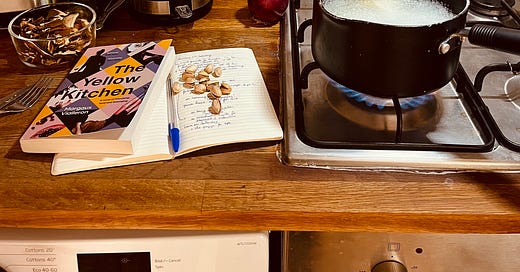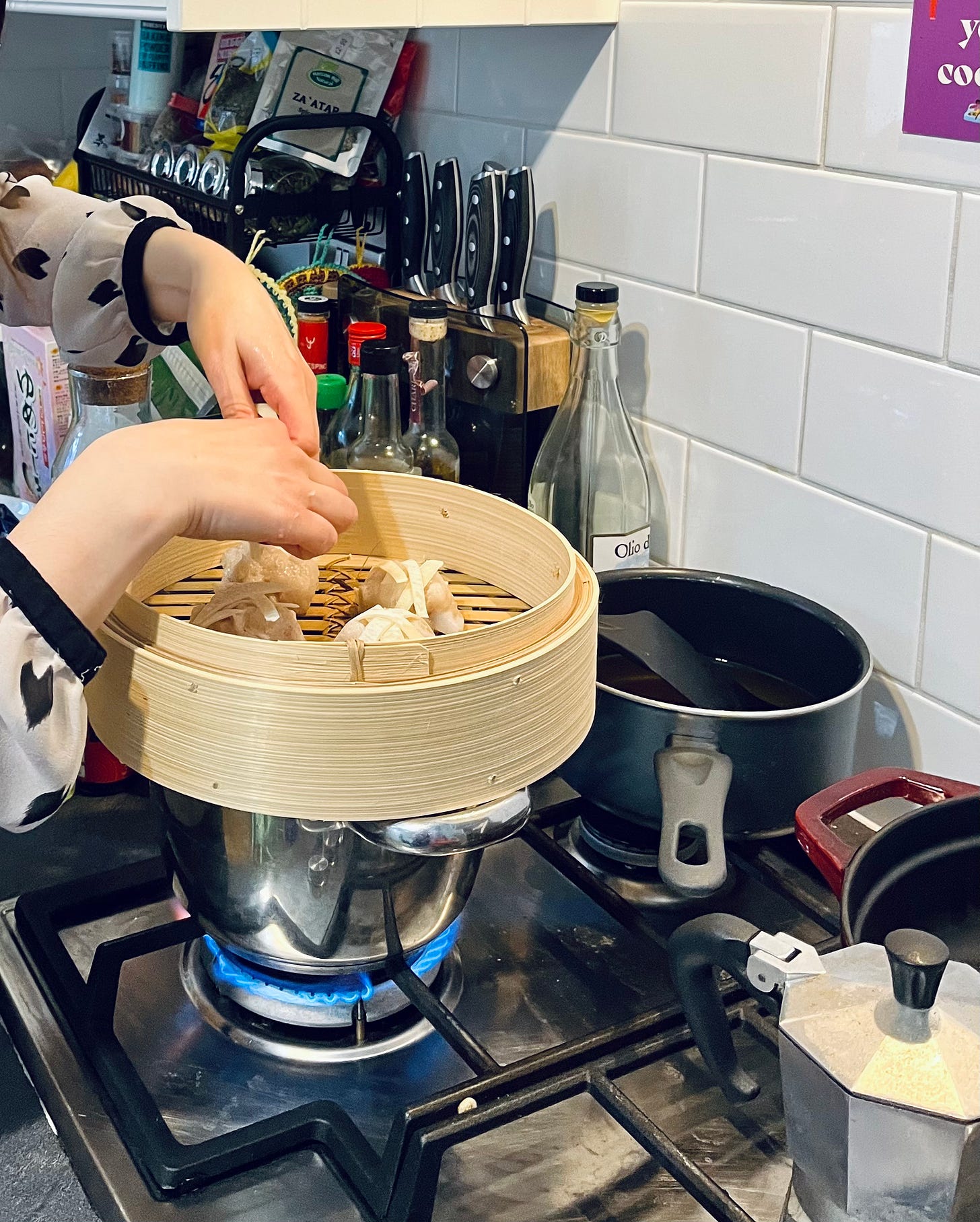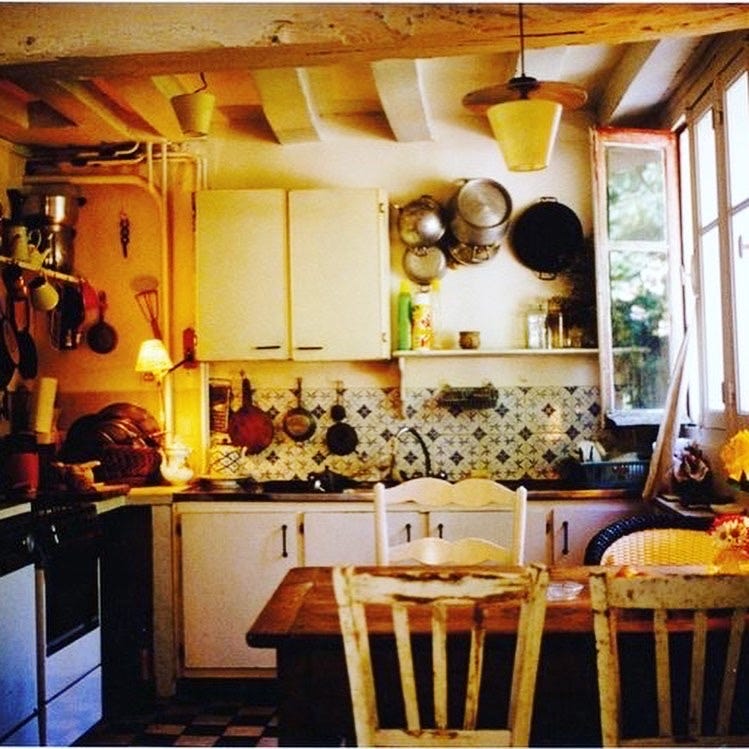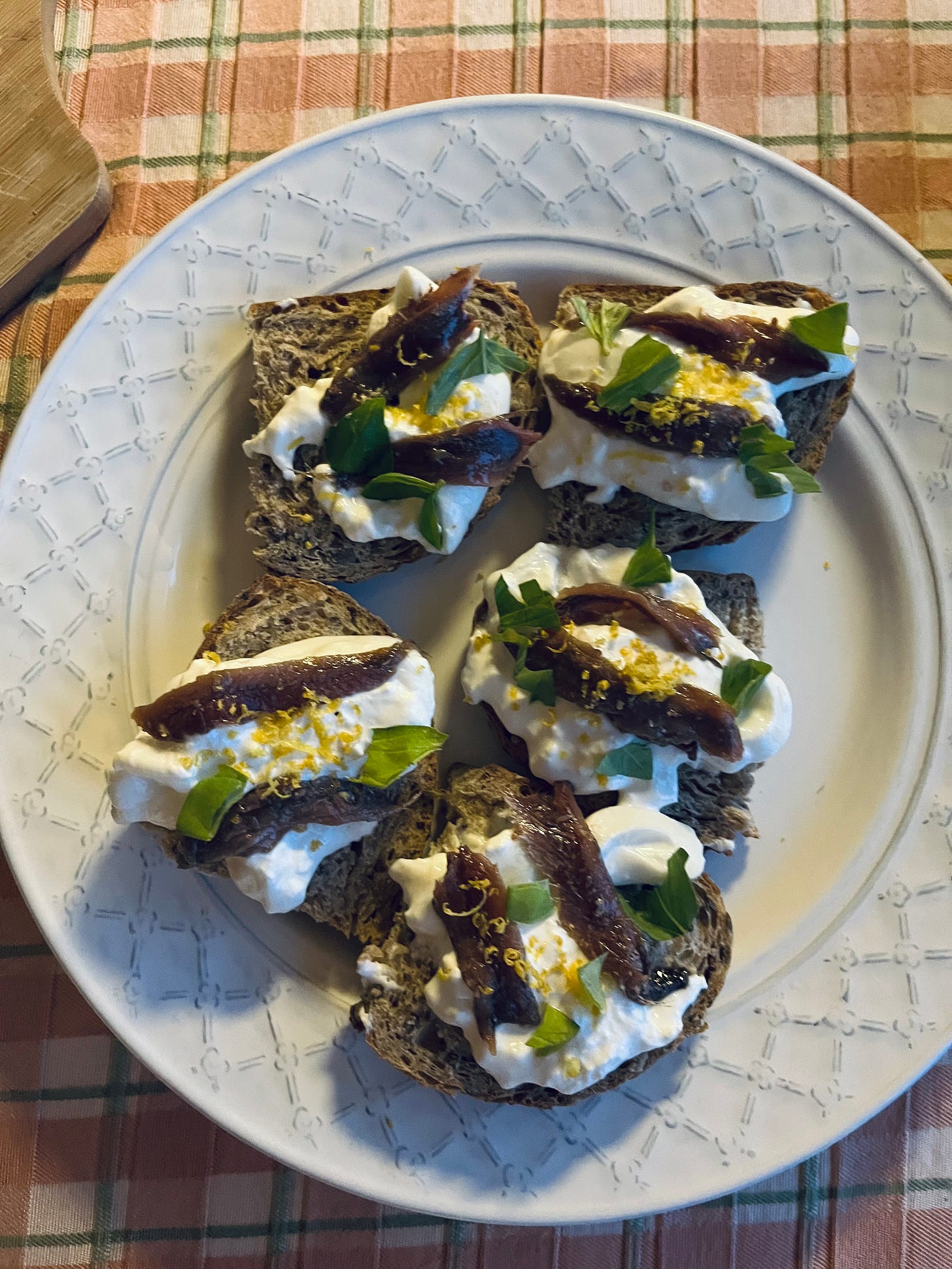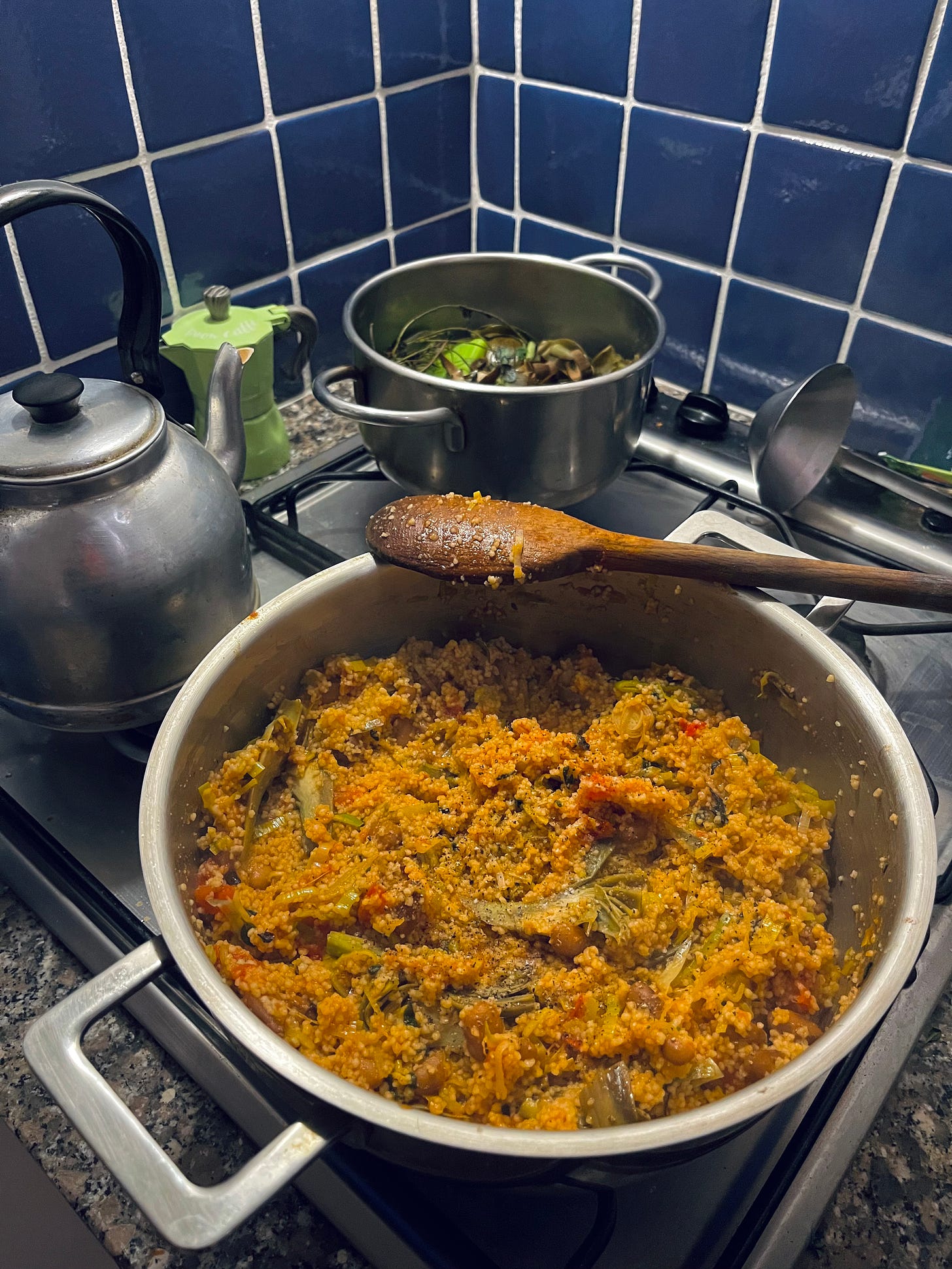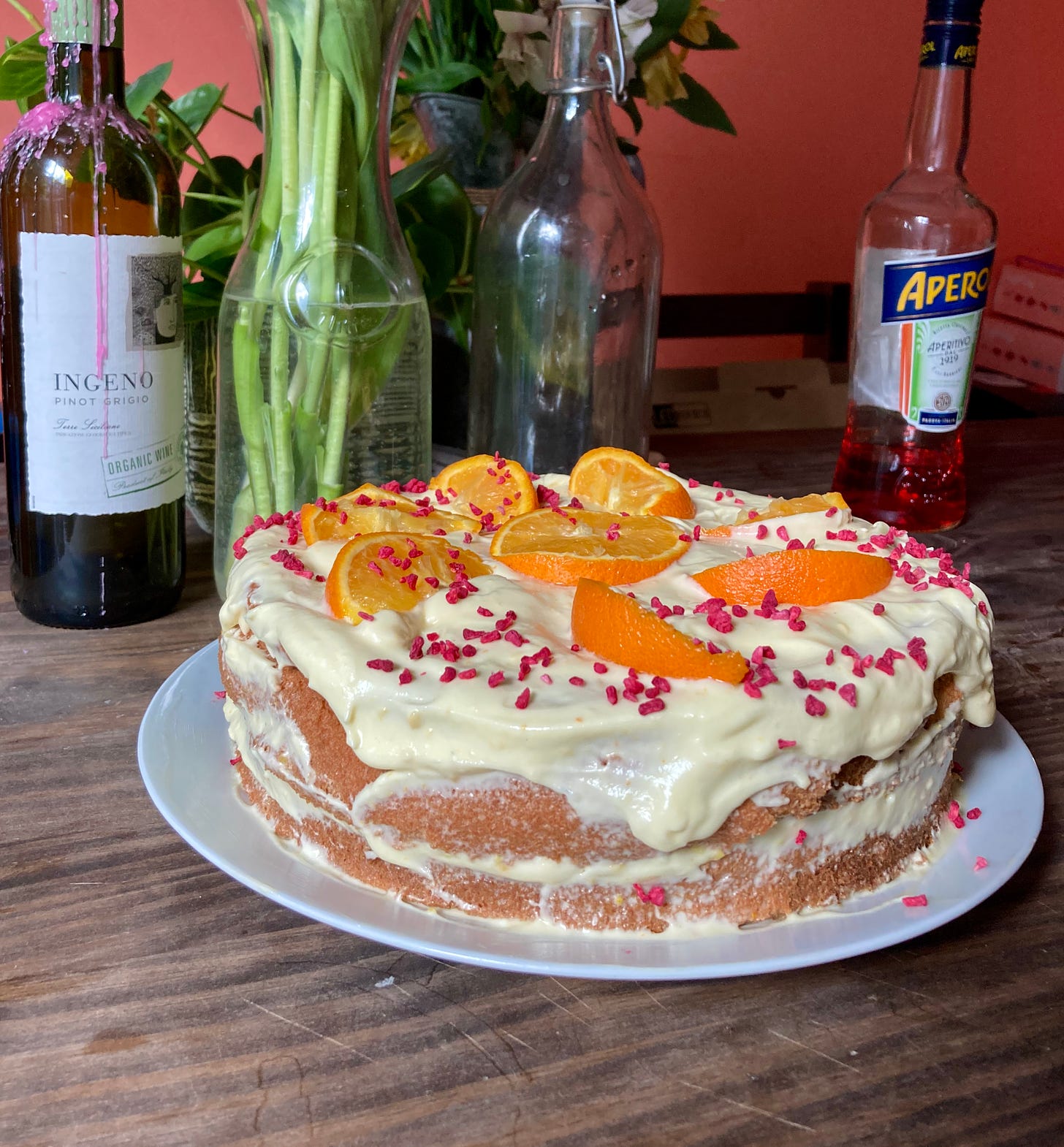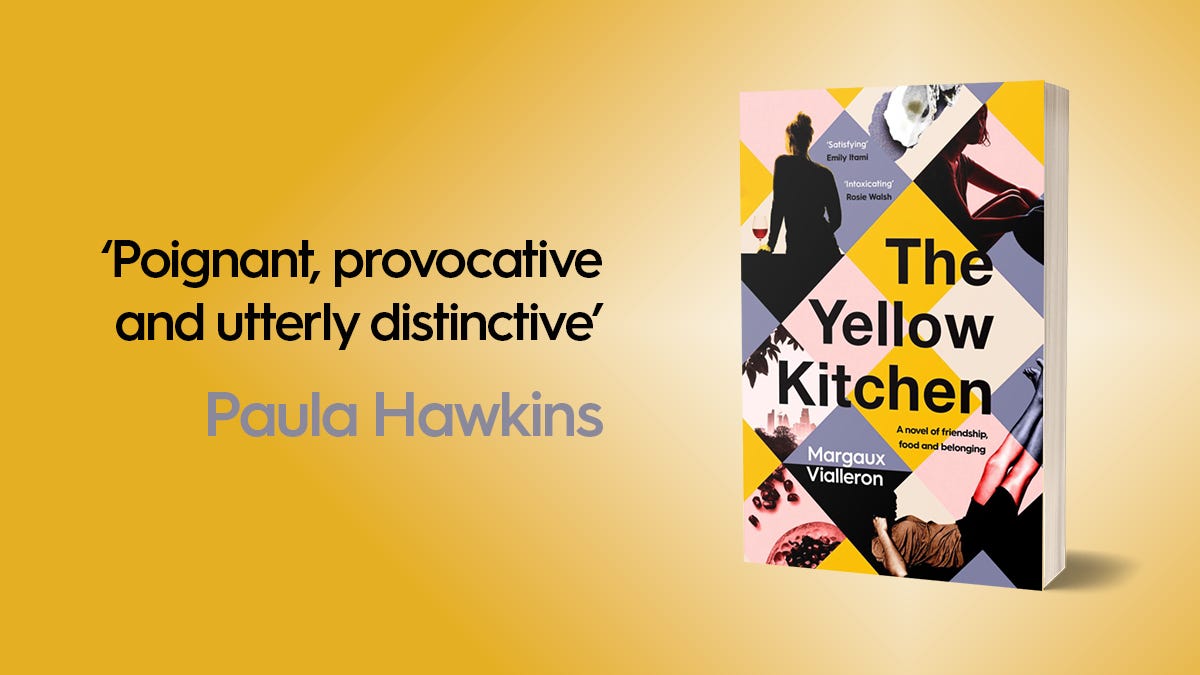The Yellow Shade of Time
cooking for friends, writing and fragility; a dinner party drawn from memory
Irene has the hands of a pianist. Last Saturday, I sat at Irene’s kitchen table and I watched her closing squid dumplings with the care that shadows her actions. We had been apart for almost three months, and we were now reunited in a different kitchen from the one where we had said goodbye. Irene spooned a mixture of squid and shallots into a dumpling pastry sheet, closed it by pinching the edges with her fingertips, then wrapping them with pastry stripes, and she placed the dumpling into a steamer. She repeated the same steps in a chain until we were fed. I followed her with my eyes while the other guests interacted, and there I found an old thread to pick up: friendship.
I think about chronologies in the kitchen often. The timer goes on when the tart should be checked, a delicate odour comes through; the oven clock goes off with the electric switchboard and I won’t bother resetting it, flashing and menacing; the kitchen space rhythms my days and appetites, I share meals with other generations through the execution of a recipe. I relish in the melancholia as much as the thought makes me spiral. But the timeline in my shared kitchen with my best friend, Irene, is linear: we work on it so there will be another meal to serve, and so regardless of how much we are able to physically cook together. I receive photos of what Irene chops and simmers often; I send her messages while I wait for a loaf of bread to bake; she gifted me my first sourdough starter and I gave her a piece of it to grow her own; we aren’t afraid of sharing a meal via video call. We’re friends in the kitchen because there we mark time as a progression – it goes on.
‘I have threaded most of my friendships around cooking and eating. A committed introvert who interprets silence as a form of communication, I enjoy standing in front of the hob, swirling the contents of a saucepan with a wooden spoon and catching occasional sight of the person who is sitting behind me at the dining table. I hope they are snacking – a mixture of olives, some crisps, or I have splashed some olive oil and balsamic vinegar, with a pinch of salt and a sprinkle of oregano, into a bowl and sliced some bread for them – and I am listening. The frying chemistry of a soffritto is keeping me attentive and, there, I have noticed people open up. I love getting to meet someone while I cook for them, and I adore falling in love with them while we eat together.’
– extract from the author’s note of the paperback edition of The Yellow Kitchen
Last Thursday, the paperback edition of The Yellow Kitchen published. It hit me with a new wave of fragility: this book I started writing over four years ago – pre, during and post pandemic – a novel that documents a London so far and so close at the same time; the delicacy of being a certain age and to write about that specific age, to learn to love and to live, to embody one’s identity. The Yellow Kitchen is dreamlike to me; a book I can hold in my hands, the pages I flick through with naïve excitement because I have spent so much time meandering through them, and a book I would now approach through the prism of a creative practice that has unavoidably changed over the years. We often warn authors about the ‘second book syndrome’, I wish we spoke more about how writing that second book makes one feel about the first book – the same way I debate being friends with an ex with my pals at the pub? Last Thursday, I wandered around Soho with my girls – Claude, Giulia and Sophie, or the main protagonists of The Yellow Kitchen – and while it felt like walking on eggshells, it was affirming too. We did this, I thought – a seaweed ramen at Koya for lunch (one for me), Bar Italia for coffee and amaro (for Giulia), walking down New Bond Street and past the Wolseley (for Sophie), and reminding Claude that it’s ok to make such a show of it all. I ate a pizza with yellow tomatoes and buffalo mozzarella toppings with some of my best friends for dinner.
When I think of Annalisa, I hear her tapping golden heels as we head out for dinner until May arrives, and I ask her which cake she would like me to bake. I thank Ludovica for introducing me to the Trofie pasta; she makes a banging pesto as well. There is Johanna and the pasta with tomato sauce and aubergines we would gulp before going out dancing. I think of rosé wine too. Valentina cooks me risotto with courgettes and prawns, and we eat with our legs crossed on her sofa. A failed attempt at making a homemade galette des rois for Charlotte, Nicoletta adds a teaspoon of peanut butter to her curry.
Yellow is the colour of the grass of Hyde Park at the end of a summer of heatwaves, the shade of a bruise on the verge of healing. Children are taught to paint the sun yellow and diversion road signals are yellow. The winning jersey during the Tour de France is yellow; lemons, springtime, caution; yellow sees time passing through. Yellow is the colour of the walls inside Claude’s kitchen, just like Marguerite Duras’ kitchen.
The Yellow Kitchen is my first novel. The words stand on the page, but their meaning has left the cocoon of my personal space. I have found this gymnastic difficult: a choreography between letting go and let the book – Claude, Giulia and Sophie – meet their readers, while baring my name on the front cover. This isn’t easy because an important reason why I wrote this novel was to stop defining language as a systematic practice – because it was paralysing me. What I know is that I poured my heart into this novel and that I remember why I wrote it.
Writing is breathing. It flows through my body, its rhythms peak or crash, it indulges or limits. Writing is just like cooking, and I owe a lot of it to my friends, so this week I’m sharing a menu for a dreamt dinner party, one drawn from past dishes we cooked together.
Let’s start with something to nibble while we cook the main course. Crostini with Mozzarella di Bufala, anchovies and lemon zest:
Buffalo mozzarella, sliced
Anchovies, patted with a kitchen towel to remove the oil excess
Lemon, zest grated
Bread, sliced
On top of a slice of bread, layer some mozzarella cheese, one or two anchovy filets and sprinkle lemon zest on top.
I love couscous: it’s spoonable, versatile and you can put the casserole in the middle of the table so guests can help themselves. Couscous relieves pressures from platting the food of someone else and you will find me scrapping the pot edges, where the couscous has solidified into the chilling tomato sauce.
I’m sharing ratios for two – you can multiply quantities by how many guests or appetite you’ll be hosting:
120g couscous
120ml veggie broth
1 artichoke, cleaned and cut lengthwise
2 carrot, peeled and sliced
1 leek, thinly sliced
1 garlic clove, whole
1 handful of nepitella leaves
1 squeeze of tomato purée
½ can of chopped tomatoes
1 can of borlotti beans
S&P to taste
Start with bringing 140 ml of water to the boil (as some will evaporate and you might need extra) and simmer some broth.
Heat up some oil in a pan and fry up the nepitella, leek and garlic gently. You want to keep an eye on this as nepitella burns and crisps quickly. Add the artichokes and carrots. Once the veggies are tender and golden, remove the garlic clove and stir in the chopped tomatoes. Squeeze in some tomato purée, lower the heat, simmer.
In the meantime, pour the couscous into a heat-proofed bowl and add the broth. Cover the bowl with a kitchen towel and leave it aside for 7 to 10 minutes. Once the couscous is rehydrated (when the water has been soaked), fluff the couscous with a fork and season with salt and pepper.
Add the borlotti beans and couscous to the pan and mix with the tomato sauce and veggies. Keep the heat low, let is settle for 2 to 3 minutes.
Yellow is the colour of fragility. The ash-like texture of happiness and the disillusion of what I assume people around think of me; the ephemeris effect of writing words that will mean something different when a new era comes. I think about the chronology of life in patterns that stitch more or less together. The Yellow Kitchen is for the friends who pick-up the needle and make-up for a family.
The sweet-toothed among us must be wondering what cakes we baked for Annalisa, or perhaps it’s just me who wants to tell you about the Orange Chiffon Cake we made one sunny day in our flatshare. Either way this one requires a gargantuan number of eggs, some patience and a springform cake tin. This recipe was made in May 2020, during lockdown, therefore notes have blurred into uncertain measurements and method (consider this line a warning):
For the cake:
300g white flour
150g caster sugar
1tbsp baking powder
½ tsp salt
100ml vegetable oil
7 large egg yolks
¾ cup freshly pressed oranges
2 tbsps orange zest
1 tbsp orange water
9 large egg whites
1 tsp cream of tartar
For the icing:
200g heavy cream, chilled
3 tbsps orange extract
2 tsps freshly grated orange zest
100g caster sugar
1 tbsp rose water
1 orange, sliced (for garnish)
Preheat the oven (fan, 160C). In the meantime, in a large bowl, mix flour, 75g of the sugar, baking powder and salt. Leave aside. In a separate bowl, whisk oil, egg yolks, orange juice, orange zest and rose water. Incorporate the wet ingredients into the dry mix, whisking continuously (go forth until the batter is smooth).
In a separate bowl, beat the egg whites with a pinch of salt until foamy. If you’ve an electric whisk, you can make your life easier. Fold in the cream of tartar and keep beating until stiff, then start adding the remaining 75g of sugar while whisking continuously. Things should get glossy.
With the help of a wooden spoon, fold the batter in the egg whites gently. Spoon the batter into the dry springform cake tin. Bake the cake until golden on top and a skewer comes out clean from picking the cake (approx. 50 minutes).
While the cake bakes, put a mixing bowl to chill in the fridge. Take the cake out of the oven, turn the tin upside down onto a rack and let it cool completely. Be patient; once the cake has chilled, remove the tin carefully. Slice the cake in two, halfway and horizontally (a bread knife works best for this purpose).
Grab the bowl you had left to chill in the fridge to prepare the icing. Beat cream, orange extract and zest, rose water and sugar with the help of a whisk. Add a pinch of salt and keep whisking until the mixture holds a stiff peak.
Set the bottom layer of the cake on a serving plate and spread some of the icing on top. Close up with the other half and spread the leftover icing at the top of the cake. You can also garnish it with some orange slices.
A few weeks ago, my friend Neri rescued me from spiralling down my thoughts as we stepped on the Piazza della Repubblica in Florence. ‘You’ve intuition, remember to listen to it,’ he said. He hugged me too, but I’m not a hugger. I needed to hear this the most, and today I’m typing his words for you in case you needed to read them. We were on our way to lunch because this is what we always do together.
Pick your colour, paint your own story
Margaux
P.S. I’m doing a giveaway to celebrate friendship and will be sending a signed copy of The Yellow Kitchen to the first two subscribers who drop me a line. All you have to do is to fill up the contact form at the bottom of my website, here (please write ‘giveaway The Yellow Kitchen’ in the subject line). Open until Thursday 16th February 2023, 23:00 GMT. I’ll be in touch to ask for the winners’ details after that.


